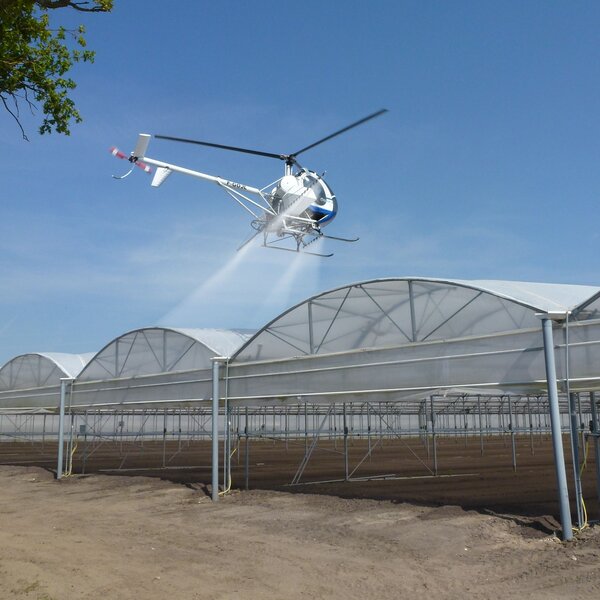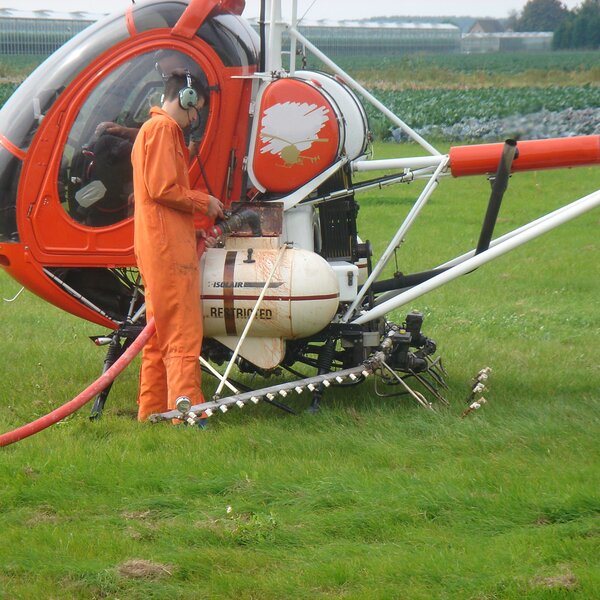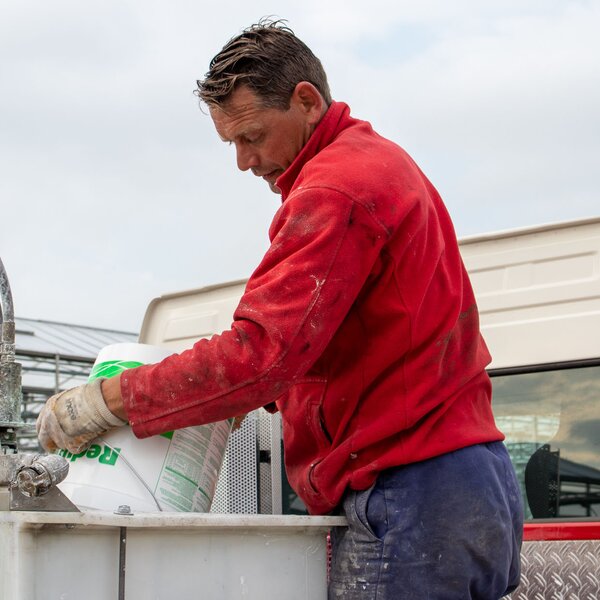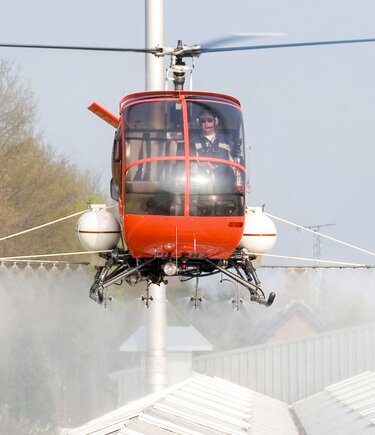Application with a helicopter or plane
The use of a helicopter or plane is a cost-effective method of coating large greenhouse cover surface areas within a short period of time. The result depends on the pilot’s knowledge and experience. The quality of the technical equipment and its level of maintenance are additional determining factors.
Drip pattern
Opting for aerial application can be a very rational choice. It is very fast, which means that the vent windows do not have to stay shut very long – this is a major benefit in a hot climate. Furthermore, the costs are relatively low. However, quality is inferior to a machine application. This is because aerial application creates a drip pattern instead of a uniform layer. This does not need to be a problem. Often this is good enough for ReduSol coatings. In comparison to a uniform layer, a drip pattern reduces the effect of diffuse coatings or products that filter light colours. To achieve a layer that is virtually uniform without making it too thick, the pilot will have to fly back and forth more often.
Weather conditions affect quality
- Apply the coating to a clean and dry greenhouse cover to obtain the best wear resistance. Pay special attention in case of new plastic. The oil layer must be removed, otherwise the coating will not adhere properly.
- Apply the coating during dry weather with relative humidity < 80% on a dry greenhouse. A wet greenhouse cover dilutes the layer. When the drying time is too long this may cause excessive run-off and therefore an uneven coating
- Keep an eye on the weather forecast. Do not apply during precipitation or when precipitation is forecast over the short-term (within 12 hours). Rain damages a coating that has not yet totally dried.
- Apply at a temperature between 10 and 25 degrees Celsius (5 and 25 degrees Celsius for ReduSol and ReduClean). Otherwise the drying time will be too long and the coating will be wet during the night and may become damaged due to condensation.
- Do not apply when windy (max. 7 km/hour). The layer may become too thin and overspray may occur.

- Calculate the total required quantity of water and coating. The required number of buckets of product is higher in case of application by helicopter or plane in comparison to manual or machine application.
- Fill a mixing tank of sufficient capacity with clean water.
- Pour the selected number of buckets of ReduSystems product into the mixing tank with water.
- Mix the spraying solution with sufficient force to create a homogeneous solution. Check that there is no remaining concentrate at the bottom.
- Apply the solution evenly on the greenhouse cover.
- Only spray when weather conditions are right.

- Determine the quantity of water and cleaning product and follow the same preparation instructions used for mixing the coating.
- Verify that the drains and the surroundings are suitable for the flow-through of rinsing water. Prevent ingress if possible.
- Apply the solution evenly on a dry greenhouse cover and let sit for at least 15 minutes before rinsing with water. A strong rain shower within one week will also wash off the coating.
- Ensure that the coating is entirely moistened. The coating on missed sections will not be removed.
- To avoid temporary white discolouration do not discharge rinsing water to stagnant waters; install the drainage system below the water surface; and discharge the rinsing water to a large moving bodies of water with sufficient capacity, where allowed.
- If you discharge ReduSystems products into the reservoir, check the water’s usability afterwards, particularly the pH.

ReduSystems products control the light entering the greenhouse. This benefits production and quality. The desired effect is highly dependent on the thickness of the coating layer. In other words, on the number of buckets product per hectare. The required number of buckets of product is higher in case of application by helicopter or plane in comparison to manual or machine application. We determine the optimal thickness on the basis of studies and we are constantly learning from actual practice. This means that our recommendation to use a specific number of buckets per hectare is well founded. The use of more or less buckets (or loss of product due to improper application) has adverse effects. Using fewer buckets than recommended reduces the intended effect on your crops. A shading product consequently might shade too little radiation or heat. Furthermore, low concentrations reduce the layer’s wear-resistance. When too many buckets are used the effect is reversed; in this case, you could lose too much growlight and thus compromise production or quality.
For every crop and situation in the world, the ReduWizard app on our website provides recommendations about the ideal product and the right quantities to be used.
safety
- If ReduSystems products come into contact with the skin or eyes, rinse off with water.
- If ingested, contact a doctor.
Frequently asked questions
The best and longest-lasting results are obtained when the coating is applied to a clean, dry greenhouse roof, as follows:
- Fill the mixing tank with the required quantity of clean water and add ReduSol, stirring continuously.
- Stir the spray liquid frequently during application.
- Apply ReduSol evenly to the greenhouse surface, preferably using a spraying machine.
- Never use any non-ReduSystems shading products in combination with ReduSol.
The ideal weather conditions for applying ReduSol
- An outside temperature between 5 and 30 ⁰C.
- Wind speed of less than 2 m/s (7 km/h). A strong wind will cause product loss and a thinner layer than intended, plus the spray could blow onto nearby objects such as cars and buildings.
- For fast drying: relative humidity (RH) < 80 %. The exact drying time also depends on other conditions (such as amount of applied ReduSol, outside temperature, glass temperature and wind speed). The coating should be dry before nightfall because condensation may damage the layer.
- Do not apply ReduSol to a wet surface or during rainfall because this may create an uneven layer of coating on the glass.
- Do not apply when rain is expected within six hours, since the coating is highly likely to be damaged or to be washed away completely.
Almost all ReduSystems products are suitable for use on plastic. The exceptions are AntiReflect and GS-4 (Xtra), which are only suitable for use on glass.
ReduFuse is safe to use on plastic greenhouses without any damage, but it is more suitable for use on glass. Many types of plastic already diffuse the light to some extent. In addition, the removal of ReduFuse should be done with a brushing machine to ensure proper removal. A better alternative is ReduFuse IR, which diffuses the light and keeps out some of the heat. ReduFuse IR can be removed without a brushing machine.
Yes, it is possible to apply layers of different ReduSystems products on top of each other. For example, ReduSol applied on top of ReduHeat will increase the shading effect in the summer.
